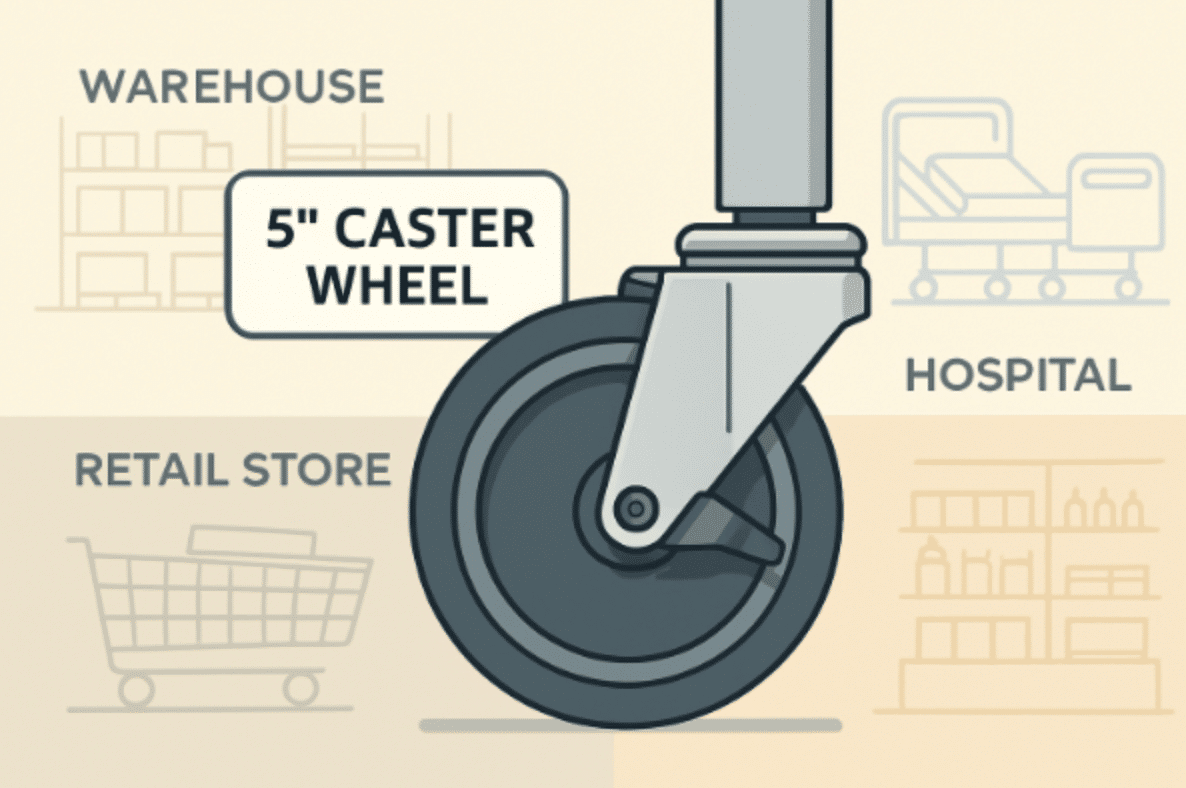Key Takeaways:
- 5-inch casters offer the ideal balance between strength and maneuverability, making them suitable for various applications.
- Their standardized size simplifies maintenance, sourcing, and replacement across industries.
- Durable materials like polyurethane and reinforced nylon ensure long-lasting performance, even under demanding conditions.
- These casters directly contribute to operational efficiency and cost savings by improving mobility, reducing strain, and enhancing safety.
Introduction to 5-Inch Casters
Mobility is key to operational efficiency in warehouses, hospitals, or retail stores. Central to this mobility are casters—specialized wheels and mounts designed to facilitate the smooth movement of equipment. Among the various types available, 5 inch caster wheels have established themselves as the industry standard for versatility and dependability, providing an optimal mix of durability and performance that meets diverse demands.
The popularity of 5-inch casters is no accident; their design strikes the perfect balance between load capacity and ease of movement. This synergy allows them to adapt seamlessly to different work environments, whether rolling across polished hospital floors or ferrying heavy machinery through rugged factory settings.
Optimal Load Capacity and Maneuverability
5-inch casters excel at supporting substantial weights without compromising maneuverability. Their size enables them to carry heavy loads, often exceeding several hundred pounds per wheel, while maintaining smooth mobility. This quality is essential for workplaces where equipment needs to be repositioned quickly and safely, helping to drive productivity and reduce manual handling injuries.
Unlike smaller casters, which may struggle with thresholds or rough surfaces, 5-inch casters easily navigate minor obstacles and uneven ground, lessening strain on staff and equipment. This combination of strength and agility is why they’re trusted across countless applications.
Versatility Across Industries
The adaptable nature of 5-inch casters has driven their widespread adoption in multiple sectors:
- Healthcare: 5-inch casters provide seamless mobility for hospital beds, medical carts, and diagnostic equipment. Their smooth, quiet operation is crucial in patient care settings, minimizing noise while enhancing efficiency and safety.
- Manufacturing: On assembly lines and factory floors, these casters make it easy to move heavy tools, components, and machinery. This flexibility helps streamline workflow and improve response times during production shifts.
- Retail: Display units, merchandise racks, and stock carts equipped with 5-inch casters allow for rapid reconfiguration of retail spaces, ensuring adaptability as inventory changes and customer needs evolve.
Many industries also appreciate the time and labor saved using standardized caster sizes, simplifying sourcing, maintenance, and replacement processes. Their broad adoption further confirms their reliable performance and universal utility.
Material Composition and Durability
The longevity of 5-inch casters is rooted in their robust construction. Most are manufactured from high-grade polyurethane, thermoplastic rubber, and reinforced nylon. Polyurethane wheels, in particular, are renowned for their durability and quiet operation. They resist wear and tear, corrosive chemicals, and even harsh weather conditions, making them suitable for indoor and outdoor applications.
Reinforced cores support heavier loads and prevent deformation over time, while sealed ball bearings contribute to smoother rolling action. This high level of engineering ensures that 5-inch casters deliver reliable, long-term performance—even in environments that push other mobility solutions to their limits.
Ergonomics and Safety Considerations
By integrating 5-inch casters into carts, beds, and equipment, organizations can improve workplace ergonomics and lower the risk of injuries. The size and smoothness of these casters reduce the force needed to move even fully loaded carts, meaning workers don’t have to strain or overexert themselves—a major factor in preventing musculoskeletal injuries. This leads to a safer, more comfortable environment for everyone, from hospital staff to logistics professionals.
Casters with features such as locking brakes and anti-static options in regulated industries further enhance safety and compliance. These advances demonstrate the ongoing innovation in caster technology driven by user needs and changing workplace standards.
Cost-Effectiveness and Maintenance
Choosing 5-inch casters is a strategic investment. Their durability translates into extended service life and less frequent replacement, which lowers total operational costs. Moreover, with 5-inch being an industry-standard size, businesses benefit from easy availability for replacements and upgrades, reducing unplanned downtime. These advantages combine to deliver a strong return on investment, particularly in high-traffic or high-impact environments.
Routine maintenance is straightforward, often limited to occasional wheel inspection and lubrication. Since these casters are built to resist debris and corrosion, upkeep costs are minimal over the long term.
Environmental Adaptability
5-inch casters are engineered to perform consistently across a variety of environmental conditions. Whether the floor is polished concrete, commercial carpet, or rough outdoor pavement, these wheels are reliable. Their tread patterns can be selected to match the flooring type, further optimizing grip and reducing rolling resistance.
This environmental adaptability is crucial for organizations operating in mixed-use facilities or locations with varying terrain—ensuring safe, efficient movement at all times.
Final Thoughts
The 5-inch caster has become synonymous with versatility, reliability, and cost-efficiency. Its dominance across numerous industries isn’t just a matter of convenience, but of carefully balanced design and proven performance. As work environments evolve, the dependability and adaptability of 5-inch casters will continue to play a critical role in keeping businesses and institutions moving forward.





